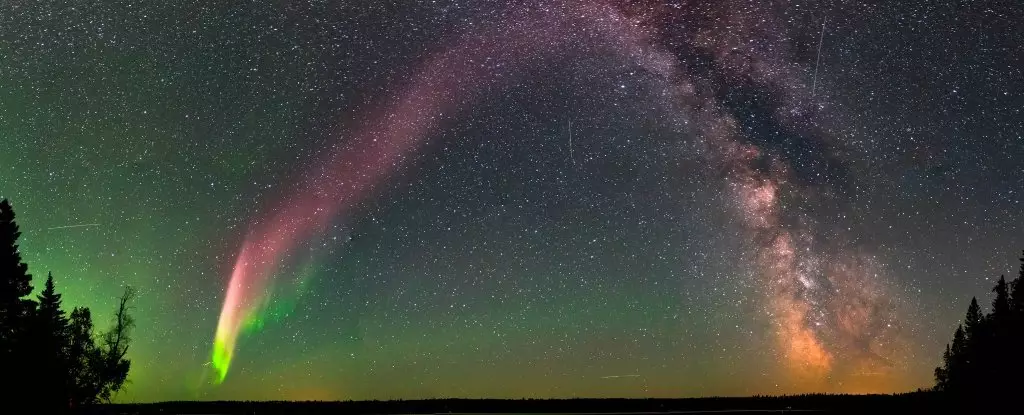

When the Sun gets rowdy, Earth’s sky lights up with beautiful dancing lights. Around the poles, colorful auroral streams dance and flicker across the sky. Closer to the equator, though, a different empyrean glow appears: the blushing, mauve-pink STEVE, and its attendant green-striped picket fence. What these lights are, and why they appear in our sky, is something of a mystery.
Scientists have previously thought that, because they look similar to auroras, they might be related, but the mechanisms behind the phenomenon have remained elusive. However, a new paper proposes a radical idea that challenges this notion. According to physicist Claire Gasque and her team from the University of California Berkeley, STEVE and the picket fence are distinctly not auroras, but something else entirely. Their groundbreaking research suggests that these phenomena are produced by electric fields parallel to the magnetic field lines, at lower latitudes than the auroras.
Auroras are, truly, one of the most beautiful sights Earth has to offer. They occur when particles from the Sun, such as those gusted out in a powerful solar wind or spewed out in a giant eruption like a flare, are flung out into space in Earth’s direction. When these particles collide with Earth’s protective magnetosphere, most of them bounce off again, but some are captured, accelerating along magnetic field lines to higher latitudes. Eventually, they are pelted down into the upper atmosphere, colliding with atmospheric atoms and molecules. The result is the mesmerizing display known as the aurora, which can exhibit a range of colors from green to yellow to pink to red to purple, depending on the ionization of specific atoms.
Green hues are indicative of oxygen, while purple or blue colors signify nitrogen. The rarest manifestation is a blood red glow, produced by oxygen situated in the upper atmosphere during highly energetic solar events. This captivating natural phenomenon has fascinated scientists with its intricate physics for decades.
Among the mesmerizing array of Earth’s celestial neighbors, there exists a mysterious glow called STEVE (Strong Thermal Emission Velocity Enhancement). This distinct mauve-and-white spectacle, accompanied by a striped green feature known as a picket fence, was officially identified as a separate phenomenon in 2018. Since then, scientists have tirelessly endeavored to unravel the secrets of STEVE.
Previously, scientists harbored the hypothesis that STEVE might be created by a subauroral ion drift (SAID), a stream of ionized atoms in the upper atmosphere that does not precipitate like traditional auroral particles. However, this explanation fails to account for the unique glow emitted by STEVE. Furthermore, the picket fence phenomenon associated with STEVE appeared to defy the conventional understanding of particle behavior.
In a groundbreaking paper, physicist Claire Gasque and her team present an alternative explanation for STEVE and the picket fence. Contrary to previous beliefs, they propose that the particles in the picket fence are being excited locally by an electric field, rather than falling from higher altitudes. This finding challenges the established mechanism behind auroras and opens up a new realm of possibilities in understanding Earth’s atmosphere and magnetosphere.
Gasque’s research suggests that STEVE could also be the result of a similar process involving electric fields. To test this hypothesis directly, the researchers propose launching a rocket into STEVE or the picket fence. While the rarity of these phenomena presents challenges, the team suggests targeting enhanced aurora regions, which are more accessible and exhibit similar colors to the picket fence.
Gasque and her colleagues acknowledge that there is much more to learn about these fascinating electric fields and their association with the transfer of energy between Earth’s atmosphere and space. The presence of these electric fields raises questions about their origin, the waves they are or are not associated with, and the implications for larger energy exchanges. As Gasque aptly observed, “It’s fair to say that there’s going to be a lot of study in the future.”
The enigmatic phenomena of STEVE and the picket fence have long puzzled scientists, but recent research has shed light on their origins. By challenging the conventional understanding of auroras, Gasque and her team have introduced the possibility of parallel electric fields playing a role in their creation. Further exploration and experimentation will be crucial in uncovering the mysteries of these captivating luminous displays and expanding our knowledge of Earth’s atmosphere and magnetosphere.
Recent advancements in the realm of theoretical physics have set the stage for a more…
Plastic waste is an environmentally pressing issue, with millions of tons of materials like Styrofoam…
Adolescence is a tumultuous period marked by transformation—not just physically, but neurologically as well. A…
Recent findings from a collaborative study led by the University of East Anglia (UEA) and…
In an era where the digital landscape is continuously evolving, the advent of quantum technology…
As we navigate the complexities of modern life on Earth, the looming threat of cosmic…
This website uses cookies.